Worry no more because Pass4itsure have the right Cisco 300-170 dumps exam solution for you. Pass4itsure high pass rate Cisco https://www.pass4itsure.com/300-170.html dumps pdf CCNP Data Center exam questions answers online.
Exam Code: 300-170
Exam Name: DCVAI Implementing Cisco Data Center Virtualization and Automation (DCVAI)
Updated: Aug 06, 2017
Q&As: 102
[100% Pass Guarantee Cisco 300-170 Dumps From Google Drive]: https://drive.google.com/open?id=0BwxjZr-ZDwwWZzkydEcwa19TQWM
[100% Pass Guarantee Microsoft 70-767 Dumps From Google Drive]: https://drive.google.com/open?id=0BwxjZr-ZDwwWaWpOOFpVd3ZyMTg
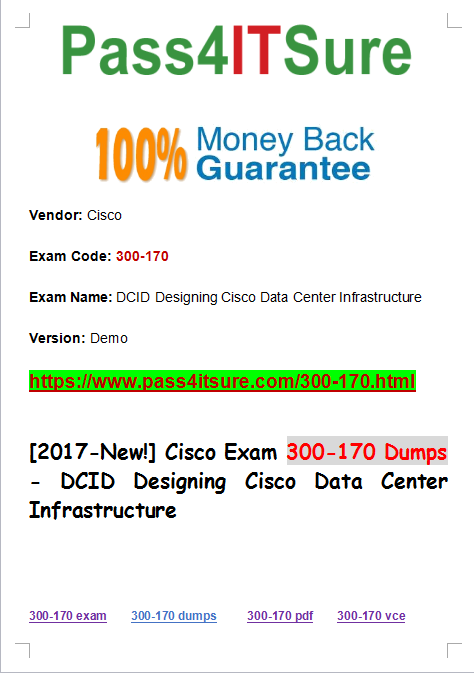
★Pass4itsure Latest and Most Accurate Cisco 300-170 Dumps Exam Q&As★
QUESTION: 1
Which of the following correctly describes the DOM (Level 2) Node interface?
A. The Node interface can be used to change the value (nodeValue) of the DOM
element node (Element)
B. The Node interface can be used to change the name (nodeName) of the DOM
element node (Element)
C. The Node interface can be used to change the value (nodeValue) of the DOM
attribute node (Attr)
D. The Node interface can be used to change the name (nodeName) of the DOM
attribute node (Attr)
300-170 exam Answer: C
QUESTION: 2
Select the following DOM (Level 2) methods that can add an attribute node (Attr) to
an element node (Element). (Multiple answers possible. Select two.)
A. appendChild
B. hasAttribute
C. setAttribute
D. setAttributeNode
Answer: C, D
QUESTION: 3
Which of the following describes the most correct call order of the ContentHandler
interface methods when parsing the following “XML Document” using a validating
SAX parser? This question reflects line feeds within the XML Document.
A. startDocument – startElement – ignorableWhitespace – startElement – characters –
endElement – ignorableWhitespace -endElement – endDocument
B. startDocument – startElement – characters – startElement – characters – endElement –
characters – endElement -endDocument
C. startDocument – startElement – startElement – characters – endElement – endElement
– endDocument
D. startDocument – startElement – startElement – characters – endElement –
ignorableWhitespace – endElement -endDocument
300-170 dumps Answer: B
QUESTION: 4
Under the SAX specification, which of the following is a method for determining
whether to validate a document with the SAX parser?
A. Use the getFeature method of XMLReader interface to look up the feature value
under the name “http://xml.org/sax/features/validation”
B. Use the parse method of XMLReader interface to investigate whether an error
occurs
C. Use the parseWithValidating method of XMLReader interface
D. Use the isValidatingParser method of XMLReader interface
Answer: A
QUESTION: 5
When processing the following “XML Document” according to the method shown by
“SAX Processing,” which of the following correctly describes the output results (print
method output)?

A. East<![CDATA[&]]>West
B. East&West
C. EastWest
D. East
300-170 pdf Answer: B
QUESTION: 6
Process the following “XML Document” according to the method shown by “DOM
Processing,” and output “article” (by print method). Select which of the following
correctly describes what should be in (1) for “DOM Processing”

A. content.getText()
B. content.getNodeValue()
C. content.getChildNode().getNodeValue()
D. content.getFirstChild().getNodeValue()
Answer: D
QUSTION: 7
Push the Exhibit Button to load the referenced “XML Document,” and process XML
using “DOM Processing”. Select which of the following is the most appropriate
expression of the results under XML 1.0. Line feeds and/or indents are not reflected in
the results.
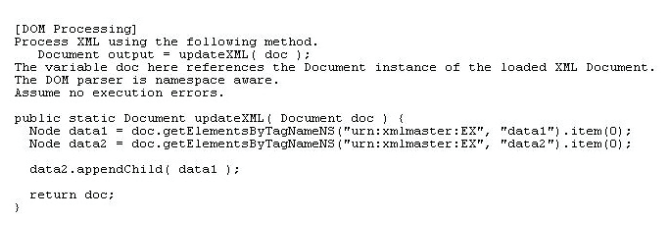
A. <root xmlns=”urn:xmlmaster:EX”>
<data1>string value</data1>
<ns:data2 xmlns:ns=”urn:xmlmaster:EX”>
<data1>string value</data1>
</ns:data2>
</root>
B. <root xmlns=”urn:xmlmaster:EX”>
<data1>string value</data1>
<data2>
<data1>string value</data1>
</data2>
</root>
C. <root xmlns=”urn:xmlmaster:EX”>
<ns:data2 xmlns:ns=”urn:xmlmaster:EX” xmlns=””>
<data1 xmlns=”urn:xmlmaster:EX”>string value</data1>
</ns:data2>
</root>
D. <root xmlns=”urn:xmlmaster:EX”>
<data2>
<data1>string value</data1>
</data2>
</root>
300-170 vce Answer: C
QUESTION: 8
When processing the following “XML Document” according to the method shown by
“DOM Processing,” which of the following correctly describes the output results (print
method output)?
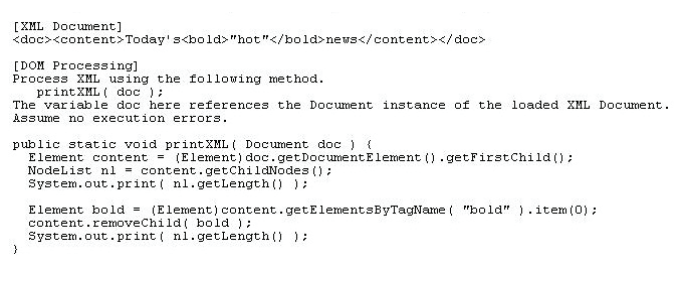
A. 44
B. 43
C. 42
D. 33
E. 32
F. 31
Answer: E
QUESTION: 9
Push the Exhibit Button to load the referenced “XML Document 1” and “XML
Document 2,” and process XML using “DOM Processing”.

Select which of the following is the most appropriate expression of the results under
XML 1.0. Line feeds and/or indents are not reflected in the results.

300-170 exam Answer: C
QUESTION: 10
Assume that the “XML Document” is changed to the “Results XML Document.” Select
which XSLT style sheet correctly performs the transformation. Note that the XSLT
processor can output transformation results as a document. [Results XML Document]
<ZZZ><YYY>lmnop</YYY></ZZZ>
A. <xsl:stylesheet version=”1.0″
xmlns:xsl=”http://www.w3.org/1999/XSL/Transform”>
<xsl:include href=”exam.xsl” />
<xsl:template match=”/”>
<xsl:apply-templates select=”root” />
</xsl:template>
<xsl:template match=”root”>
<AAA><BBB><xsl:value-of select=”data” /></BBB></AAA>
</xsl:template>
</xsl:stylesheet>
[exam.xsl]
<xsl:stylesheet version=”1.0″ xmlns:xsl=”http://www.w3.org/1999/XSL/Transform”>
<xsl:template match=”//root”>
<ZZZ><YYY><xsl:value-of select=”data” /></YYY></ZZZ>
</xsl:template>
</xsl:stylesheet>
B. <xsl:stylesheet version=”1.0″
xmlns:xsl=”http://www.w3.org/1999/XSL/Transform”>
<xsl:import href=”exam.xsl” />
<xsl:template match=”/”>
<xsl:apply-templates select=”root” />
</xsl:template>
<xsl:template match=”root”>
<AAA><BBB><xsl:value-of select=”data” /></BBB></AAA>
</xsl:template>
</xsl:stylesheet>
[exam.xsl]
<xsl:stylesheet version=”1.0″ xmlns:xsl=”http://www.w3.org/1999/XSL/Transform”>
<xsl:template match=”//root”>
<ZZZ><YYY><xsl:value-of select=”data” /></YYY></ZZZ>
</xsl:template>
</xsl:stylesheet>
C. <xsl:stylesheet version=”1.0″
xmlns:xsl=”http://www.w3.org/1999/XSL/Transform”>
<xsl:include href=”exam.xsl” />
<xsl:template match=”/”>
<xsl:apply-templates select=”root” />
</xsl:template>
<xsl:template match=”root”> <xsl:template match=”root”>
<AAA><BBB><xsl:value-of select=”data” /></BBB></AAA>
<AAA><BBB><xsl:value-of select=”data” /></BBB></AAA>
</xsl:template>
</xsl:stylesheet>
[exam.xsl]
<xsl:stylesheet version=”1.0″
xmlns:xsl=”http://www.w3.org/1999/XSL/Transform”><xsl:stylesheet version=”1.0″
xmlns:xsl=”http://www.w3.org/1999/XSL/Transform”>
<xsl:template match=”root”>
| <ZZZ><YYY><xsl:value-of select=”data” | /></YYY></ZZZ> |
| <ZZZ><YYY><xsl:value-of select=”data” /></YYY></ZZZ> | |
| </xsl:template> | |
| </xsl:stylesheet> | |
| D. <xsl:stylesheet | version=”1.0″ |
| xmlns:xsl=”http://www.w3.org/1999/XSL/Transform”>D.<xsl:stylesheet | |
| version=”1.0″ xmlns:xsl=”http://www.w3.org/1999/XSL/Transform”> | |
| <xsl:import href=”exam.xsl” /> | |
| <xsl:template match=”/”> <xsl:template match=”/”> | |
| <xsl:apply-templates select=”root” /> <xsl:apply-templates select=”root” /> | |
| </xsl:template> | |
| <xsl:template match=”root”> <xsl:template match=”root”> | |
| <AAA><BBB><xsl:value-of select=”data” /></BBB></AAA> | |
| </xsl:template> | |
| </xsl:stylesheet> | |
| [exam.xsl] | |
| <xsl:stylesheet version=”1.0″ xmlns:xsl=”http://www.w3.org/1999/XSL/Transform”> | |
| <xsl:template match=”root”> <xsl:template match=”root”> | |
| <ZZZ><YYY><xsl:value-of select=”data” | /></YYY></ZZZ> |
| <ZZZ><YYY><xsl:value-of select=”data” /></YYY></ZZZ> | |
| </xsl:template> | |
| </xsl:stylesheet> | |
| Answer: A | |
| QUESTION: 11 | |
| Which of the following text strings is not output to the results document when | |
| performing an XSLT transformation on the following “XML Document” using the | |
| “XSLT Style Sheet” below? Note that the XSLT processor can output transformation | |
| results as a document. |
A. doc
B. NS1:title
C. body
D. NS1:section
E. NS1:content
300-170 dumps Answer: C
QUESTION: 12
Push the Exhibit Button to load the referenced “XML Document”.
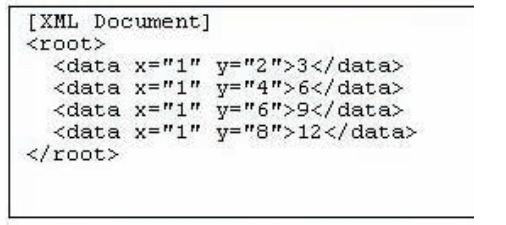
Assume that the character “3” is obtained from the “XML document”. Select which
XSLT style sheet correctly performs the transformation. (Multiple answers possible.
Select two.)
| A. <xsl:stylesheet | version=”1.0″ |
| xmlns:xsl=”http://www.w3.org/1999/XSL/Transform”> | |
| <xsl:template match=”/”> | |
| <xsl:apply-templates select=”//data[x=’1′][y=’2′]”/> | |
| </xsl:template> | |
| </xsl:stylesheet> | |
| B. <xsl:stylesheet | version=”1.0″ |
| xmlns:xsl=”http://www.w3.org/1999/XSL/Transform”> | |
| <xsl:template match=”/”> | |
| <xsl:apply-templates select=”//data[(attribute::x=’1′) and (text()=’3′)]”/> | |
| </xsl:template> | |
| </xsl:stylesheet> | |
| C. <xsl:stylesheet | version=”1.0″ |
| xmlns:xsl=”http://www.w3.org/1999/XSL/Transform”> | |
| <xsl:template match=”/”> | |
| <xsl:apply-templates select=”//data[self=’3′]”/> | |
| </xsl:template> | |
| </xsl:stylesheet> | |
| D. <xsl:stylesheet | version=”1.0″ |
| xmlns:xsl=”http://www.w3.org/1999/XSL/Transform”> | |
| <xsl:template match=”/”> | |
| <xsl:apply-templates select=”//data[self::*=’3′]”/> | |
| </xsl:template> | |
| </xsl:stylesheet> |
Answer: B, D
QUESTION: 13
Which of the following correctly describes the output results when performing an
XSLT tranformation on the following “XML Document” using the “XSLT Style
Sheet” below? Note that the XSLT processor can output transformation results as a
document.
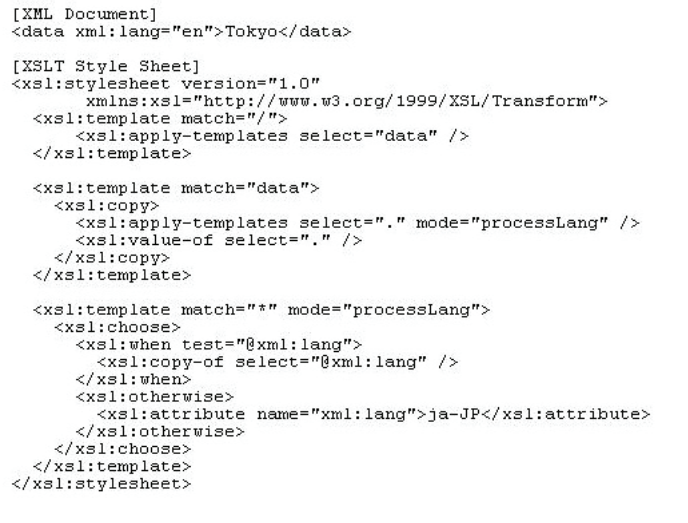
A. <data/>
B. <data>Tokyo</data>
C. <data xml:lang=”en”>Tokyo</data>
D. <data xml:lang=”ja-JP”>Tokyo</data>
300-170 pdf Answer: C
We put the value for your money and guarantee you to be Cisco 300-170 dumps certified together with over 90,000 satisfied Cisco 300-170 professionals who passed their CCNP Data Center certification https://www.pass4itsure.com/300-170.html dumps in one take.